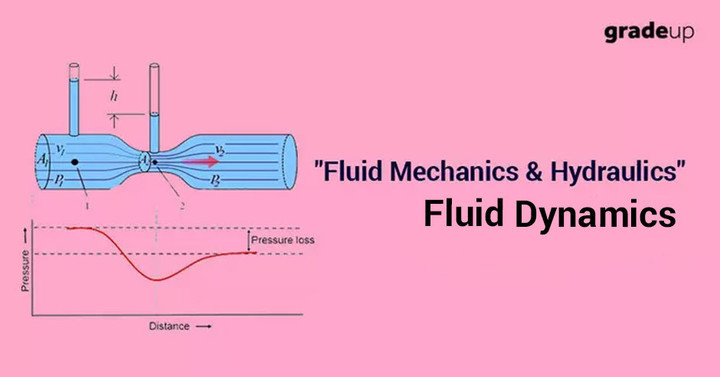Fluid mechanics Introduction
Fluid Dynamics and Flow Measurements
Fluid Dynamics
Fluid Dynamics is the beginning of the determination forces which cause motion in fluids. This section includes various forces such as Inertia, Viscous, etc., Bernoulli's theorems, Vortex motion, forced motion etc.

Include momentum correction factor, impact of jets etc.
Dynamics is that branch of mechanics which treats the motion of bodies and the action of forces in producing or changing their motion.
Flow rate
- Mass flow rate
- Volume flow rate - Discharge
- More commonly we use volume flow rate Also know as discharge. The symbol normally used for discharge is Q.
Continuity
This principle of conservation of mass says matter cannot be created or destroyed. This is applied in fluids to fixed volumes, known as control volumes (or surfaces).
- For any control volume, the principle of conservation of mass defines,
Mass entering per unit time = Mass leaving per unit time + Increase of mass in control vol per unit time
- For steady flow there is no increase in the mass within the control volume,
Mass entering per unit time = Mass leaving per unit time
Applying to a stream-tube
Mass enters and leaves only through the two ends (it cannot cross the stream tube wall).
Mass enters and leaves only through the two ends (it cannot cross the stream tube wall).
for steady flow,
ρ1∂A1u1 = ρ2∂A2u2= Constant= Mass flow rate
This is the continuity equation.
Some example applications of Continuity
A liquid is flowing from left to right. By the continuity, ρ1A1u1 = ρ2A2u2
As we are considering a liquid,
ρ1=ρ2
Q1 = Q2
A1u1=A2u2
Velocities in pipes coming from a junction
mass flow into the junction = mass flow out
ρ1Q1= ρ2Q2 + ρ3Q3
When incompressible,
Q1 = Q2 + Q3
A1u1=A2u2 + A3u3
Vortex flow
- This is the flow of rotating mass of fluid or flow of fluid along curved path.
Free vortex flow
- No external torque or energy required. The fluid rotating under certain energy previously given to them. In a free vortex mechanics, overall energy flow remains constant. There is no energy interaction between an external source and a flow or any dissipation of mechanical energy in the flow.
- Fluid mass rotates due to the conservation of angular momentum.
- Velocity inversely proportional to the radius.
- For a free vortex flow
vr= constant
v= c/r
- At the center (r = 0) of rotation, velocity approaches to infinite, that point is called singular point.
- The free vortex flow is irrotational, and therefore, also known as the irrotational vortex.
- In free vortex flow, Bernoulli’s equation can be applied.
Examples include a whirlpool in a river, water flows out of a bathtub or a sink, flow in centrifugal pump casing and flow around the circular bend in a pipe.
Forced vortex flow
- To maintain a forced vortex flow, it required a continuous supply of energy or external torque.
- All fluid particles rotate at the constant angular velocity ω as a solid body. Therefore, a flow of forced vortex is called as a solid body rotation.
- Tangential velocity is directly proportional to the radius.
- v = r ω
- ω = Angular velocity.
- r = Radius of fluid particle from the axis of rotation.
- The surface profile of vortex flow is parabolic.
- In forced vortex total energy per unit weight increases with an increase in radius.
- Forced vortex is not irrotational; rather it is a rotational flow with constant vorticity 2ω.
Examples of forced vortex flow is rotating a vessel containing a liquid with constant angular velocity, flow inside the centrifugal pump.
Energy Equations
- This is the equation of motion in which the forces due to gravity and pressure are taken into consideration. The common fluid mechanics equations used in fluid dynamics are given below
- Let, Gravity force Fg, Pressure force Fp, Viscous force Fv , Compressibility force Fc , and Turbulent force Ft.
Fnet = Fg + Fp + Fv + Fc + Ft
- If fluid is incompressible, then Fc = 0
∴ Fnet = Fg + Fp + Fv + Ft
This is known as Reynolds equation of motion.
- If fluid is incompressible and turbulence is negligible, then, Fc = 0, Ft = 0
∴ Fnet = Fg + Fp + Fv
This equation is called as Navier-Stokes equation.
- If fluid flow is considered ideal then, a viscous effect will also be negligible. Then
Fnet = Fg + Fp
This equation is known as Euler’s equation.
- Euler’s equation can be written as:


Comments